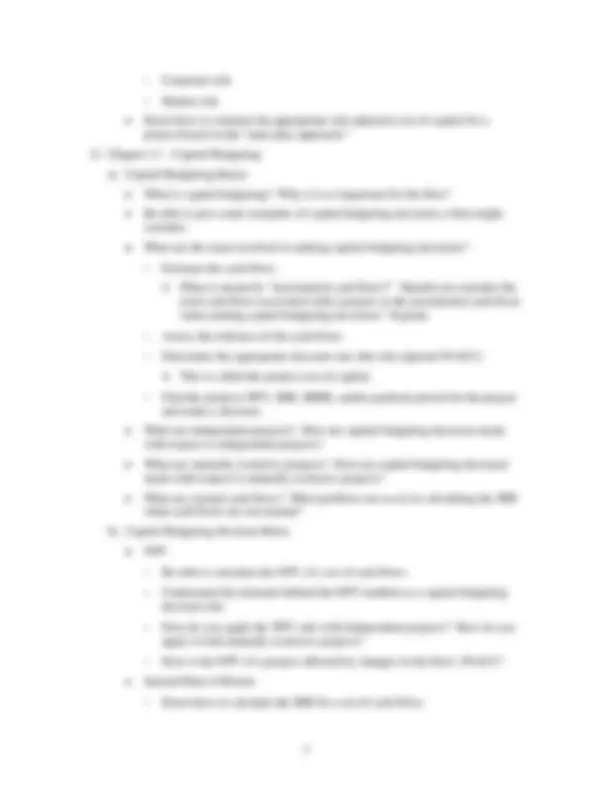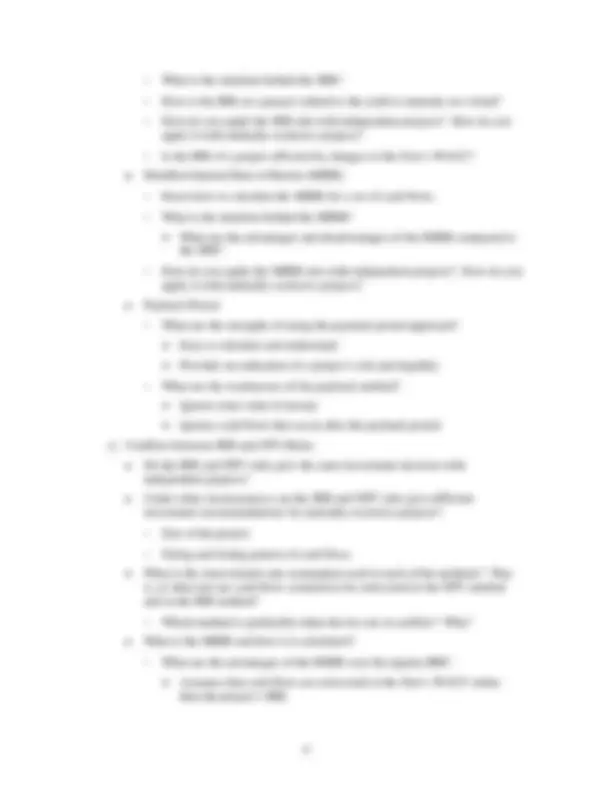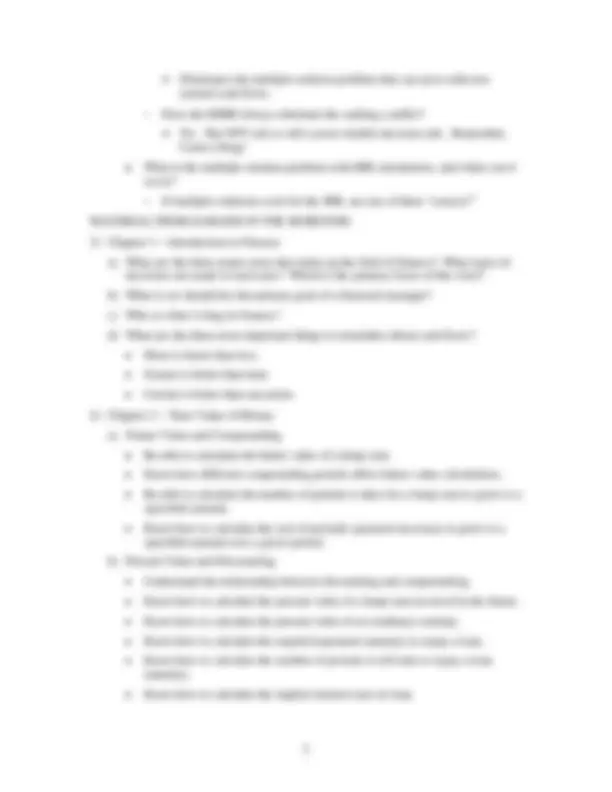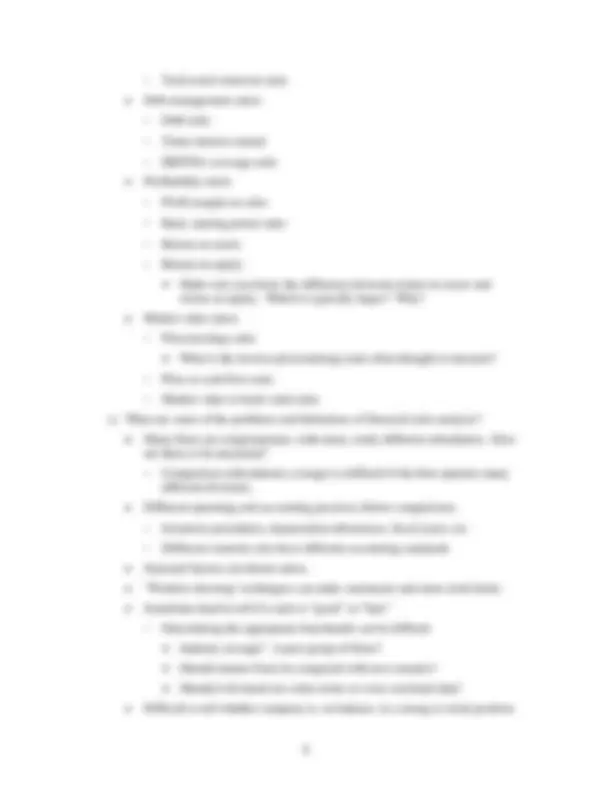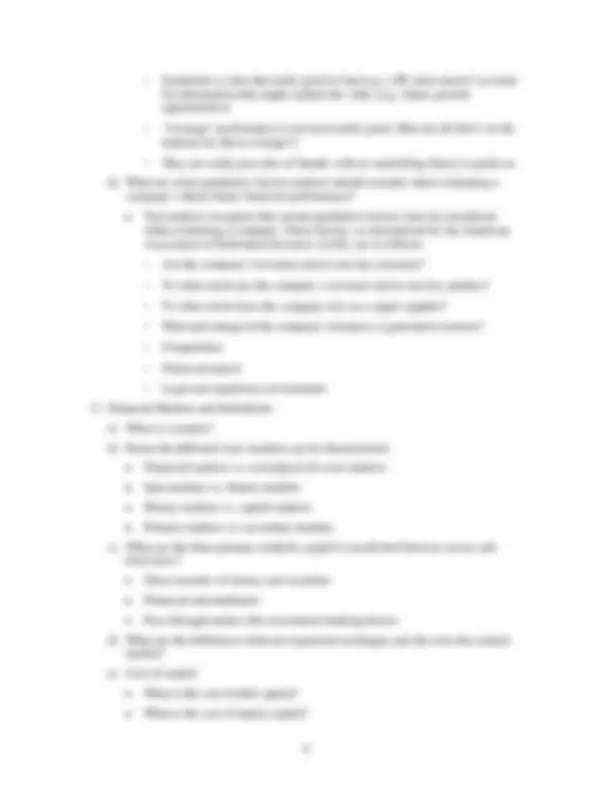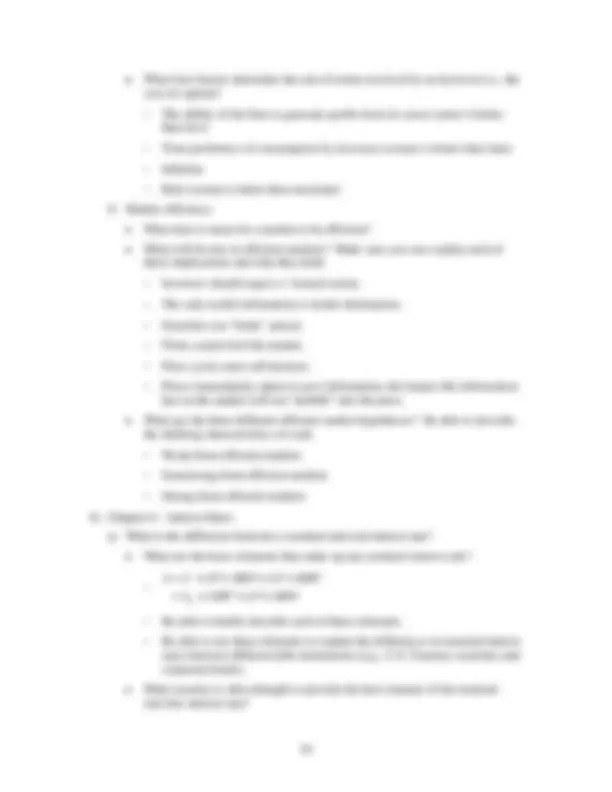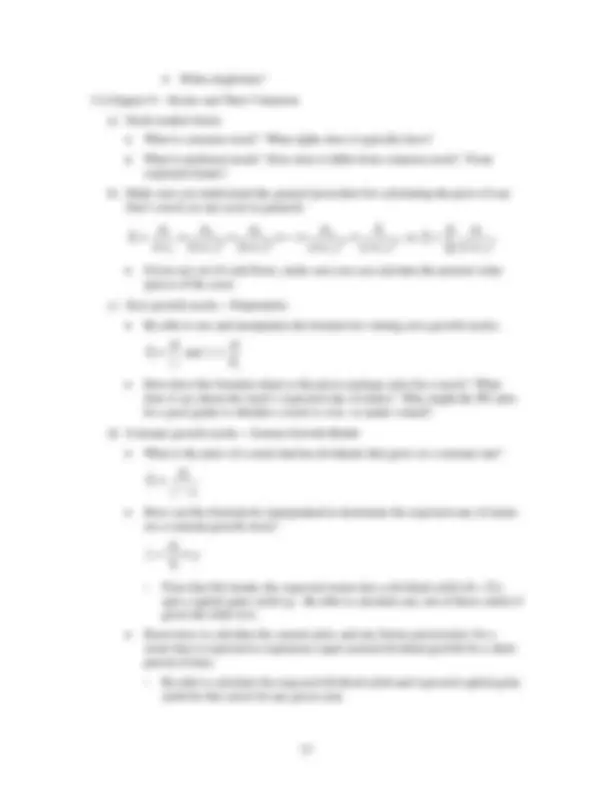Download Outlines of Financial Management I for Final Exam | FIN 340 and more Exams Financial Management in PDF only on Docsity!
Finance 340 – Financial Management I
Spring 2008 Final Review
Dr. Stanley D. Longhofer TTh 11:00-12:
This review sheet outlines the information that will be covered on the final exam. The exam will primarily consist of multiple-choice and true-false questions, although I include some problems and short-answer questions.
Most of the exam will devoted to the most recent material (chapter 10 and 11). The material in the class builds on itself, however, so you will need to be familiar with material from the entire course. I will also ask some questions on material specifically from earlier chapters.
I will use this review sheet as my outline to make up the exam. Some of the questions I will ask may come directly from this sheet. Sample problems are provided on a separate handout.
- Chapter 10 − Cost of Capital
a) Basic Concepts Behind the Cost of Capital.
- Make sure you understand that the cost of capital for a firm measures the overall cost of all the sources of financing for its long-term assets: − Long-term debt − Preferred stock − Common equity − Any other capital used to finance long-term assets
- How is the firm’s cost of capital used? − A “hurdle rate” for making investment decisions (IRR method) − Discount rate for doing NPV calculations − The opportunity cost of funds for the firm − Remember that the cost of capital is not based on the specific financing that will be used to fund a specific project, but rather the firm’s overall cost of financing all of its assets
- Why is the weighted average cost of capital (WACC) calculated on an after- tax basis? − Whose tax rate matters, that of the firm or that of the firm’s investors?
- Is WACC calculated using historical (book) costs or marginal (market) costs? Why?
b) Cost of Components
- Debt − Be able to calculate the yield to maturity on corporate bonds and then to apply the firm’s corporate tax rate to get the component cost of debt.
- Preferred Stock − Be able to calculate the cost of preferred stock given information about its dividend and market price.
- Equity − Make sure you can calculate the cost of retained earnings using any of the methods discussed in class: ¾ CAPM (based on the firm’s beta) ¾ Discounted cash flows (rearranging the formula for the value of a constant growth stock) ¾ How can you estimate g from accounting data? ¾ Own bond plus a risk premium ¾ Know how to calculate an overall cost of equity by averaging the numbers you obtain from these three methods. − Why do flotation costs raise the cost of equity for a firm that must issue new stock to finance investment? ¾ Know how to calculate the cost of new equity with flotation costs.
c) Calculating WACC
- Know how to put together the component parts to calculate firm’s WACC.
- Know how to use WACC to make investment decisions − I expect that there will be at least one question that will require you to calculate the WACC for a firm and then make a capital budgeting decision using this WACC (combining material from Chapters 10 and 11).
d) WACC and Risk
- Should the firm use the composite WACC as the hurdle rate for each of its projects? − What type of adjustment needs to be made? − Are there circumstances under which a firm with a 12% WACC would want to accept a project with an expected return of 10%? Would this firm ever want to reject a project with a 14% return? Explain.
- What types of risk can we consider with respect to a project? Be able to explain the differences between each type of risk briefly. − Stand-alone project risk
− What is the intuition behind the IRR? − How is the IRR on a project related to the yield to maturity on a bond? − How do you apply the IRR rule with independent projects? How do you apply it with mutually exclusive projects? − Is the IRR of a project affected by changes in the firm’s WACC?
- Modified Internal Rate of Return (MIRR) − Know how to calculate the MIRR for a set of cash flows. − What is the intuition behind the MIRR? ¾ What are the advantages and disadvantages of the MIRR compared to the IRR? − How do you apply the MIRR rule with independent projects? How do you apply it with mutually exclusive projects?
- Payback Period − What are the strengths of using the payback period approach? ¾ Easy to calculate and understand ¾ Provides an indication of a project’s risk and liquidity − What are the weaknesses of the payback method? ¾ Ignores time value of money ¾ Ignores cash flows that occur after the payback period
c) Conflicts between IRR and NPV Rules
- Do the IRR and NPV rules give the same investment decision with independent projects?
- Under what circumstances can the IRR and NPV rules give different investment recommendations for mutually exclusive projects? − Size of the project − Sizing and timing pattern of cash flows
- What is the reinvestment rate assumption used in each of the methods? That is, at what rate are cash flows assumed to be reinvested in the NPV method and in the IRR method? − Which method is preferable when the two are in conflict? Why?
- What is the MIRR and how is it calculated? − What are the advantages of the MIRR over the regular IRR? ¾ Assumes that cash flows are reinvested at the firm’s WACC rather than the project’s IRR.
¾ Eliminates the multiple solution problem that can arise with non- normal cash flows. − Does the MIRR always eliminate the ranking conflict? ¾ No. The NPV rule is still a more reliable decision rule. Remember, Cash is King!
- What is the multiple solution problem with IRR calculations, and when can it occur? − If multiple solutions exist for the IRR, are any of them “correct?”
MATERIAL FROM EARLIER IN THE SEMESTER:
- Chapter 1 − Introduction to Finance
a) What are the three major areas that make up the field of finance? What types of decisions are made in each area? Which is the primary focus of this class? b) What is (or should be) the primary goal of a financial manager? c) Who or what is king in finance? d) What are the three most important things to remember about cash flows?
- More is better than less.
- Sooner is better than later.
- Certain is better than uncertain.
- Chapter 2 − Time Value of Money
a) Future Value and Compounding
- Be able to calculate the future value of a lump sum.
- Know how different compounding periods affect future value calculations.
- Be able to calculate the number of periods it takes for a lump sum to grow to a specified amount.
- Know how to calculate the size of periodic payment necessary to grow to a specified amount over a given period. b) Present Value and Discounting
- Understand the relationship between discounting and compounding.
- Know how to calculate the present value of a lump sum received in the future.
- Know how to calculate the present value of an (ordinary) annuity.
- Know how to calculate the required payment (annuity) to repay a loan.
- Know how to calculate the number of periods it will take to repay a loan (annuity).
- Know how to calculate the implicit interest rate on loan.
- I will not ask you to prepare an income statement for a firm. However, you should be able to interpret each of the entries of the income statement if one is given to you.
- What is the difference between net income and cash flow?
- What is depreciation? − What is the economic idea behind depreciation? − Why does the depreciation entry on the balance sheet not necessarily match up with true economic depreciation?
- In contrast to the balance sheet, the income statement measures “flows” not a “stock.” What exactly does this mean? d) Market value added and economic value added
- Know the basic ideas behind these concepts and what they measure. You will not, however, be required to calculate these numbers. e) Federal income taxation
- What is the difference between a marginal tax rate and an average tax rate?
- What do we mean when we say that corporate profits are subject to double taxation?
- What is the corporate operating loss carry-forward? How does is benefit firms?
- Chapter 4 − Ratio Analysis
a) What are financial ratios and for what are they used? b) What are the five categories of ratios?
- Note, I will not ask you to memorize the formulae for any of the ratios we discussed (you may include them on your one page of notes). However, you should know how to characterize and interpret these ratios. − What does each ratio measure? − How do different ratios differ from one another? − What are their strengths and weaknesses?
- Liquidity ratios − Current ratio − Quick ratio
- Asset management ratios − Inventory turnover ratio − Days sales outstanding − Fixed assets turnover ratio
− Total assets turnover ratio
- Debt management ratios − Debt ratio − Times interest earned − EBITDA coverage ratio
- Profitability ratios − Profit margin on sales − Basic earning power ratio − Return on assets − Return on equity ¾ Make sure you know the difference between return on assets and return on equity. Which is typically larger? Why?
- Market value ratios − Price/earnings ratio ¾ What is the inverse price/earnings ratio often thought to measure? − Price to cash flow ratio − Market value to book value ratio
c) What are some of the problems and limitations of financial ratio analysis?
- Many firms are conglomerates, with many vastly different subsidiaries. How are these to be measured? − Comparison with industry averages is difficult if the firm operates many different divisions.
- Different operating and accounting practices distort comparisons. − Inventory procedures, depreciation allowances, fiscal years, etc. − Different countries also have different accounting standards
- Seasonal factors can distort ratios.
- “Window dressing” techniques can make statements and ratios look better.
- Sometimes hard to tell if a ratio is “good” or “bad.” − Determining the appropriate benchmark can be difficult ¾ Industry average? A peer group of firms? ¾ Should mature firms be compared with new entrants? ¾ Should it be based on a time series or cross-sectional data?
- Difficult to tell whether company is, on balance, in a strong or weak position.
- What four factors determine the rate of return received by an investor (i.e., the cost of capital)? − The ability of the firm to generate profits from its assets (more is better than less) − Time preference of consumption by investors (sooner is better than later) − Inflation − Risk (certain is better than uncertain) f) Market efficiency
- What does it mean for a market to be efficient?
- What will be true in efficient markets? Make sure you can explain each of these implications and why they hold. − Investors should expect a “normal return. − The only useful information is inside information. − Securities are “fairly” priced. − Firms cannot fool the market. − Price cycles must self destruct. − Prices immediately adjust to new information; the impact this information has on the market will not “dribble” into the price.
- What are the three different efficient market hypotheses? Be able to describe the defining characteristics of each. − Weak-form efficient markets − Semistrong-form efficient markets − Strong-form efficient markets
- Chapter 6 − Interest Rates
a) What is the difference between a nominal and real interest rate?
- What are the basic elements that make up any nominal interest rate?
k DRP LP MRP
k k IP DRP LP MRP = rf + + +
− Be able to briefly describe each of these elements. − Be able to use these elements to explain the differences in nominal interest rates between different debt instruments (e.g., U.S. Treasury securities and corporate bonds).
- What security is often thought to provide the best estimate of the nominal risk-free interest rate?
b) Term structure of interest rates
- What is the yield curve and what does it measure?
- What can we learn by looking at the yield curve?
- How can we use the yield curve to gather information about future expected interest rates?
- Chapter 7 − Bonds and Their Valuation
a) Know the key terminology/concepts relating to bonds:
- Par value
- Coupon rate
- Maturity
- Call provisions
- Sinking fund provisions
- What is interest rate risk? Which bond has more interest rate risk, an annual payment 1-year bond or a 30-year bond? Why?
- What is reinvestment risk? Which has more reinvestment risk, a 1-year bond or a 10-year bond? b) Know how to do all calculations associated with bonds:
- Price of a bond given its coupon rate and current market rates
- Yield to maturity of a bond given its current price and coupon rate
- Yield to call of a callable bond
- Current yield, capital gains yield, and total expected return − Make sure that give any two of these values you can calculate the third.
- Effective annual rate of a bond with payments that occur more frequently than annually
- Zero coupon bond prices and yields
- Perpetuity prices and yields c) You will need to understand the basic relationship between bond prices and market interest rates. Be able to explain why bond prices move the way they do.
- Why does the price of a bond rise when market interest rates fall?
- What will happen to the price of a premium bond as it approaches maturity if market interest rates remain constant over time? Why?
- What will happen to the price of a discount bond as it approaches maturity if market rates remain constant over time? Why?
- Chapter 8 − Risk and Rates of Return
a) What is risk? Be able to provide a working definition of this term.
¾ With a high beta?
- Chapter 9 − Stocks and Their Valuation
a) Stock market basics
- What is common stock? What rights does it typically have?
- What is preferred stock? How does it differ from common stock? From corporate bonds? b) Make sure you understand the general procedure for calculating the price of any firm’s stock (or any asset in general):
( ) ( ) s N
N N s
N s s s r
P
r
D
r
D
r
D
r
D
P
3
3 2
1 2 0
= L or ∑
∞
= +
1
0 ( 1 )
t
t s
t r
D
P
- Given any set of cash flows, make sure you can calculate the present value (price) of the asset. c) Zero growth stocks − Perpetuities
- Be able to use and manipulate the formula for valuing zero growth stocks:
r s
D
P ˆ 0 = and 0
P
D
rs =
- How does this formula relate to the price-earnings ratio for a stock? What does it say about the stock’s expected rate of return? Why might the PE ratio be a poor guide to whether a stock is over- or under-valued? d) Constant growth stocks − Gorton Growth Model
- What is the price of a stock that has dividends that grow at a constant rate?
r g
D
P
s −
- How can this formula be manipulated to determine the expected rate of return on a constant growth stock?
g P
D
rs = + 0
ˆ^1
− Note that this breaks the expected return into a dividend yield ( D 1 / P 0 ) and a capital gains yield ( g ). Be able to calculate any one of these yields if given the other two.
- Know how to calculate the current price and any future period price for a stock that is expected to experience super-normal dividend growth for a short period of time. − Be able to calculate the expected dividend yield and expected capital gains yield for this stock for any given year.
e) Market equilibrium
- Make sure you understand the distinction between the expected rate of return ( r ˆ ), the required rate of return ( s r (^) s ), and the ex post realized return on the stock investment ( rs )
- Which of these two are equal when the market is in equilibrium?
- Why is there strong pressure for stock markets to constantly move toward equilibrium?

